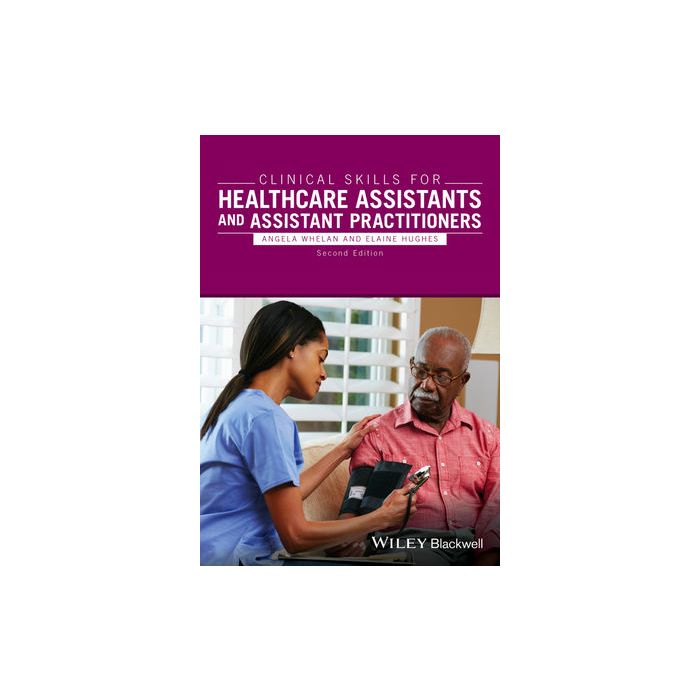Clinical Skills for Healthcare Assistants and Assistant Practitioners, 2ed. [Whelan - Wiley - Blackwell]

- ISBN/EAN
- 9781118256411
- Editore
- Wiley - Blackwell
- Formato
- Brossura
- Anno
- 2016
- Edizione
- 2
- Pagine
- 336
Disponibile
34,16 €
Clinical Skills for Healthcare Assistants and Assistant Practitioners is an accessible, easy-to-read guide, outlining the fundamental and core skills integral to clinical practice.
Fully updated in its second edition, this book is divided into three sections; the first looks at fundamental skills applicable to all staff, such as accountability, communication and record keeping. Section two explores core clinical skills such as respiratory care, pulse, blood glucose management and catheter care. Section three outlines complex clinical skills that require more in-depth training, such as medication and intravenous cannulation.
An invaluable resource for healthcare assistants and assistant practitioners, this book will also be of use to newly qualified practitioners, and students in health and social care.
Maggiori Informazioni
| Autore | Whelan Angela; Hughes Elaine |
|---|---|
| Editore | Wiley - Blackwell |
| Anno | 2016 |
| Tipologia | Libro |
| Lingua | Inglese |
| Indice | Section I Fundamental skills 1. Accountability Aim of this chapter Regulation and Registration Health Care Assistants and Assistant Practitioners Responsibilities and Accountability Delegation Related aspects and terminology Summary Self-assessment 2. Communication in healthcare Aim of this chapter Defining Communication Why good communication is important Communication methods Strategies to improve communication Related aspects and terminology Skills for Health Certificate Summary of good communication Self-assessment Addendum 3. Psychological well-being Aim of this chapter What is meant by psychological care? Psychological assessment in the healthcare setting The importance of psychological care in the healthcare setting Strategies to optimise psychological wellbeing Pharmacological (drug-related) options Non-pharmacological options Therapeutic sense of self Common problems Summary Self-assessment 4. Documentation and record keeping Aim of this chapter The importance and purpose of documentation in relation to clinical skills Confidentiality in records and documentation Types of documentation Legal aspects relating to documentation Common problems Related aspects and terminology Strategies to improve standards of record keeping Self-assessment Section II Core clinical skills 5. Pulse Aim of this chapter What is a pulse? Relevant anatomy and physiology Related aspects and terminology Factors affecting the pulse rate Terminology Automated devices Fetal heartbeat Documentation Common problems Summary Self-assessment 6. Blood pressure monitoring Aim of this chapter What is blood pressure? Reasons for monitoring blood pressure Who requests the test? Who can take a BP reading? What is done with the readings/information? Relevant anatomy and physiology Related aspects and terminology Terminology Equipment Sites for recording blood pressure Taking blood pressure Documentation Common problems Summary Self-assessment 7. Temperature Aim of this chapter What is temperature? Reasons for measuring temperature Normal limits Relevant anatomy and physiology Related aspects and terminology Terminology Taking a temperature reading Route Taking a temperature reading Documentation Common problems Summary Self-assessment 8. Pulse oximetry Aim of this chapter What is an oxygen saturation reading? Who can perform the test? Reasons for recording an oxygen saturation level Relevant anatomy and physiology Related aspects and terminology The mechanics of pulse oximetry Equipment Normal readings Using a pulse oximeter Documentation Common problems Summary Self-assessment 9. Respiratory care Aim of this chapter What is respiratory care? Relevant anatomy and physiology Upper respiratory system Lower respiratory system Recording a respiratory rate How to measure and record a respiratory rate accurately Measuring and recording a peak expiratory flow rate Performing suctioning Related aspects and terminology Common problems Summary Self-assessment Addendum 10. Urinalysis and faecal occult blood testing Aim of this chapter Reasons for performing urinalysis and FOB tests Relevant anatomy and physiology Urinalysis testing Faecal occult blood testing Related aspects and terminology (Tortora and Derrickson 2006) Common problems Summary Self-assessment Addendum 11. Urinary catheterisation and catheter care Aim of this chapter Urinary catheterisation Relevant anatomy and physiology Types of catheterisation Patient preparation for catheterisation Insertion technique Catheter care Sampling Removal of catheter Related aspects and terminology Terminology Common problems Summary Self-assessment 12. Venepuncture Aim of this chapter Reasons for performing venepuncture Relevant anatomy and physiology Common sites for venepuncture Infection Hand hygiene Aseptic (sterile) technique Health and Safety Environment Performing the skill: requirements and technique Related aspects and terminology Common problems Summary Self-assessment 13. Blood glucose monitoring Aim of this chapter What causes diabetes? Reasons for performing blood glucose measurement Relevant anatomy and physiology Related aspects and terminology Blood glucose levels Hypoglycaemia Hyperglycaemia Common problems Summary Self-assessment 14. Fluid balance and intravenous maintenance Aim of this chapter Reasons for monitoring fluid balance Related anatomy and physiology Electrolytes Related aspects and terminology Fluid balance charts The intravenous route Care of the cannula Discontinuing an IV infusion Common problems Summary Self-assessment Section 3: Complex clinical skills 15. Medicines Aim of this chapter The role of the Healthcare Assistants and Assistant Practitioner in relation to medicine administration Types of medicines Medication prescribing and legal aspects Related aspects and terminology Common medications Errors in administration and adverse reactions Summary 16. Peripheral intravenous cannulation Aim of this chapter Reasons for cannulation Why perform peripheral IV cannulation Relevant anatomy and physiology How to insert and remove a peripheral IV cannula Environment Performing peripheral IV cannula: requirements and technique Patient education for peripheral IV cannulation Related aspects and terminology Common problems/potential complications of peripheral IV cannulation Summary Self-assessment 17. Recording a 12-lead ECG Aim of this chapter Relevant anatomy and physiology The cardiac conduction system Reasons for recording a 12-lead ECG How to perform a 12-lead ECG Related aspects and terminology Common problems and actions Summary Self-assessment Index |
| Disponibilità | Prossima Pubblicazione - Prenotabile |
Questo libro è anche in:
